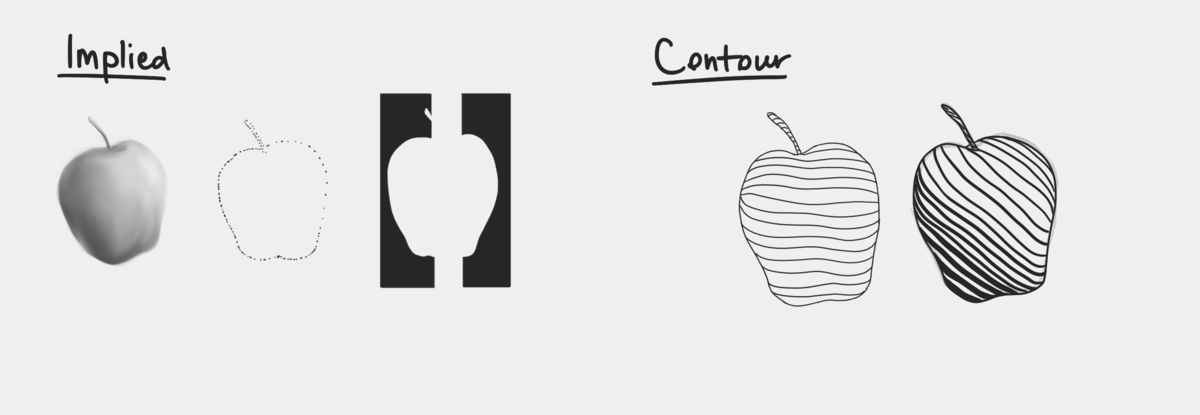In these next few posts we'll learn about the Elements of Art. We can think of them as the foundation of what all art is built upon. Using these elements, we'll come to learn how to utilize them in the art we want to create. They help us understand reasoning behind certain artistic choices in addition to helping us convey a message through our own artwork. I think it’s important to start with the very basics so we can build into more complex ideas from there.
Line
The first elements we will discuss is Line. Line, in a basic art sense, is essentially a stroke of any mark-making utensil. In art, lines can appear in many ways as well as accomplish many things. There are a number of types of lines including vertical, horizontal, diagonal, curved, zigzag, thick, thin…etc. These are demonstrated below.

Still more examples of types of lines include implied lines and contour lines. Contour lines are lines that follow along the path of a drawn object to give it the appearance of depth and dimension. Implied lines give the impression that a line is there, when in fact it isn’t physically drawn as such. Implied lines can be achieved through many methods including accurate shading of an object, through dots (as opposed to actual lines), and with stereotypical “optical illusion” imagery.

What exactly do lines do? Different lines can do a various number of things. Some artists use lines to direct our attention a certain way, or to cause us to feel a certain way. For example, zigzag lines can make us feel tension, while curvy lines can make us feel calmer.

Other artists use tricks of perception in art to make images more aesthetically pleasing. For example, when drawing a character, some artists choose to include a thicker outline around them while keeping the inner lines thin or different colors. (Some of this, however, crosses into the element of color which we’ll learn about later…) Also, when drawing, as a general rule, some artists try to keep thicker lines in the foreground of a piece and thinner lines toward the background to give the viewer a sense of depth within the piece.
These are the essentials when it comes to dealing with and using line in art. Of course, we can go beyond these basics, as well as bend the rules a little if we want to create a different idea in our own art. However, these basics are in place to give us an idea of what our creation will portray to a viewer.
Exercise
For this week’s exercise, let’s try our hand at exploring using different line types. We’ll create drawings with various types of line. Since some of us are just starting out, I’ll keep this one simple just to get acquainted with putting pencil to paper.
Let’s start out by drawing several different shapes. Then we’ll add line to them in various ways. I’ve done a few examples below (including my thoughts on them), but really you can feel free to try out whatever you like. See if you can really tell what different line types do to a drawing and what they convey.

Weekly Challenge
If you want to try your hand at something a little more challenging, give this a shot: try drawing an object from real life or by finding an image online. You can choose to draw anything around you or simply search for a simple image on Google.
I chose to draw an apple, as has been demonstrated in the examples throughout this post. Again, any image or object will do, just make sure not to overwhelm yourself and go with something simple. (Fruits are easy to use because they generally are a simple shape, but can also have different textures and colors.) But, once you’ve selected your image or object, we’ll try and draw it while incorporating different line types.
First, take the object and try to draw it using only straight lines, either diagonal, vertical, or horizontal--it doesn’t matter. We’re just experimenting in different line types. Keep in mind, this doesn’t have to be perfect. Just do your best and give yourself a challenge!
Next, try your hand at experimenting with several line types. You can even try some examples I've shown above. Or, simply mess around with combining different line types together and see what effect it gives. Let your creativity flow and really try out things that you might not think work together. You might be surprised what you discover!
Next Week
Next week we'll learn about the element of Texture! We'll incorporate what we've learned today about line into texture as well. Be sure to practice and do those exercises and challenges if you're up for it!
You can follow me on twitter, instagram, and facebook and post your drawings! I'd love to see what you all create! Also, I'd love your feedback on what you think of these posts and if there's anything I can do to help you all out :)
Until next week...
